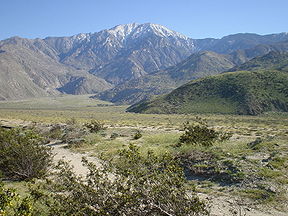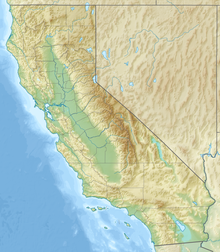San Jacinto Peak
| San Jacinto Peak | |
|---|---|
| San Jacinto Mountain | |
 The northern slopes and foothills of the peak | |
| Highest point | |
| Elevation | 10,834 ft (3,302 m) NAVD 88[1] |
| Prominence | 8,319 ft (2,536 m) ↓ San Gorgonio Pass[2] |
| Isolation | 20.3 mi (32.7 km) → Bighorn Mountain |
| Listing | |
| Coordinates | 33°48′53″N 116°40′46″W / 33.814712342°N 116.679438022°W[1] |
| Naming | |
| English translation | Saint Hyacinth's Peak |
| Language of name | Spanish |
| Geography | |
| Location | Riverside County, California, U.S. |
| Parent range | San Jacinto Mountains |
| Topo map | USGS San Jacinto Peak |
| Climbing | |
| First ascent | 1874 by "F. of Riverside" |
| Easiest route | Tramway and trail hike |
San Jacinto Peak (/ˌsæn həˈsɪntoʊ, - dʒəˈ-, - jəˈ-/ SAN hə-SIN-toh, - jə-, - yə-; often designated Mount San Jacinto) is a 10,834 ft (3,302 m) peak in the San Jacinto Mountains, in Riverside County, California. Lying within Mount San Jacinto State Park it is the highest both in the range and the county, and serves as the southern border of the San Gorgonio Pass. Naturalist John Muir wrote of San Jacinto Peak, "The view from San Jacinto is the most sublime spectacle to be found anywhere on this earth!"[4]
San Jacinto Peak is one of the most topographically prominent peaks in the United States, and is ranked the sixth most prominent peak in the 48 contiguous states.[5] According to John W. Robinson and Bruce D. Risher, authors of The San Jacintos, "No Southern California hiker worth his salt would miss climbing 'San Jack' at least once."[6]
Known for its spectacular north escarpment, the peak rises over 8,000 feet (2,400 m) above San Gorgonio Pass. It plays host to the famous Cactus to Clouds Trail.
Geography
[edit]To the east of San Jacinto, the 10,834 ft (3,302 m) peak towers over the city of Palm Springs (elevation 479 ft; 146 m); to the west, it borders the mountain community of Idyllwild (elevation 5,413 ft; 1,650 m). The peak is also frequently called Mount San Jacinto. The steep escarpment of its north face, above Snow Creek, climbs over 10,000 feet (3,000 m) in 7 miles (11 km). This is one of the largest gains in elevation over such a small horizontal distance in the contiguous United States.
From the peak, San Gorgonio Mountain can be seen across the San Gorgonio Pass. Also easily visible below is the Coachella Valley and the Salton Sea. In addition, much of the Inland Empire, including Ontario to the west, can be viewed on a clear day.
Named after Hyacinth of Caesarea, Mount San Jacinto is one of the "Four Saints," a name occasionally used to describe the high points of the four mountains over 10,000 feet named for Catholic saints in Southern California: San Jacinto Peak, Mount San Gorgonio (high point of the San Bernardino Mountains), San Bernardino Peak, and Mount San Antonio (high point of the San Gabriel Mountains).
Climate
[edit]| Climate data for San Jacinto Peak 33.8144 N, 116.6817 W, Elevation: 10,233 ft (3,119 m) (1991–2020 normals) | |||||||||||||
|---|---|---|---|---|---|---|---|---|---|---|---|---|---|
| Month | Jan | Feb | Mar | Apr | May | Jun | Jul | Aug | Sep | Oct | Nov | Dec | Year |
| Mean daily maximum °F (°C) | 38.8 (3.8) |
37.7 (3.2) |
41.0 (5.0) |
45.8 (7.7) |
53.8 (12.1) |
63.7 (17.6) |
68.6 (20.3) |
67.9 (19.9) |
62.8 (17.1) |
54.2 (12.3) |
45.5 (7.5) |
39.3 (4.1) |
51.6 (10.9) |
| Daily mean °F (°C) | 26.4 (−3.1) |
25.8 (−3.4) |
28.0 (−2.2) |
32.5 (0.3) |
39.1 (3.9) |
47.6 (8.7) |
53.4 (11.9) |
53.2 (11.8) |
48.6 (9.2) |
39.9 (4.4) |
32.3 (0.2) |
26.7 (−2.9) |
37.8 (3.2) |
| Mean daily minimum °F (°C) | 13.9 (−10.1) |
14.9 (−9.5) |
15.0 (−9.4) |
19.2 (−7.1) |
24.4 (−4.2) |
31.6 (−0.2) |
38.1 (3.4) |
38.5 (3.6) |
34.3 (1.3) |
25.7 (−3.5) |
19.2 (−7.1) |
14.2 (−9.9) |
24.1 (−4.4) |
| Average precipitation inches (mm) | 6.98 (177) |
7.11 (181) |
4.20 (107) |
1.68 (43) |
0.68 (17) |
0.14 (3.6) |
0.72 (18) |
1.90 (48) |
1.09 (28) |
1.60 (41) |
2.43 (62) |
4.47 (114) |
33 (839.6) |
| Average snowfall inches (cm) | 25.2 (64) |
23.8 (60) |
24.5 (62) |
8.6 (22) |
5.4 (14) |
0.0 (0.0) |
0.0 (0.0) |
0.0 (0.0) |
0.0 (0.0) |
1.8 (4.6) |
13.9 (35) |
15.8 (40) |
119 (301.6) |
| Source 1: PRISM Climate Group[7] | |||||||||||||
| Source 2: WRCC (snowfall)[8] | |||||||||||||
History
[edit]The peak is known to the Cahuilla Native Americans as I a kitch (or Aya Kaich), meaning "smooth cliffs." It is regarded as the home of Dakush, the meteor and legendary founder of the Cahuilla.[9]
In 1878, a Wheeler Survey topographical party led by rancher Charles Thomas of Garner Valley climbed the peak. The Wheeler Survey gave the mountain the name "San Jacinto Peak" (rather than "Mt. San Jacinto" or "San Jacinto Mountain.")[10] The earliest recorded ascent of the peak was made in September, 1874 by "F. of Riverside," according to a description of his ascent in the San Diego Union. The first successful ascent of the difficult northeast escarpment was made in 1931 by Floyd Vernoy and Stewart White of Riverside.[6] The peak is flanked by Jean Peak 10,670 feet (3,250 m) and Marion Mountain 10,362 feet (3,158 m). These peaks were named in 1897 by USGS topographer Edmund Taylor Perkins Jr. Perkins named Jean Peak for his sweetheart and future bride, Jean Waters of Plumas County, whom he married in 1903. He named Marion Mountain after Marion Kelly, his girlfriend, a teacher for the Indian Bureau at the Morongo Valley Reservation. According to a local legend, Perkins spent the summer of 1897 deciding which woman to marry while he conducted his topographical survey of San Jacinto Peak and its environs.[6]
Nearby Cornell Peak is named for Cornell University, the alma mater of geologist Robert T. Hill. Perkins and Hill were camping in Round Valley when Hill remarked that the peak looked like the campanile tower at Cornell. Perkins later named the peak Cornell Peak.[6]
In 1931 and 1932, the San Jacinto Mountain Chamber of Commerce sponsored a Labor Day footrace from Idyllwild to San Jacinto Peak and back, a distance of 18 miles (29 km) and a rise of 5,300 feet (1,600 m). The 1931 race was won by Tom Humphreys, a Hopi, in 3:36:30. Humphreys won the race again in 1932 with a time of 3:12.[11] Near the summit of San Jacinto peak is a stone hut that was built in 1935 by the Civilian Conservation Corps under the direction of Serbo-Croatian immigrant Alfred Zarubicka, a stonemason known in Idyllwild as "Zubi."[12]
Hiking
[edit]
San Jacinto Peak is easily accessible, as many trails penetrate the Santa Rosa and San Jacinto Mountains National Monument. The most popular[citation needed] route starts with a ride on the Palm Springs Aerial Tramway from Valley Station at 2,643 feet (806 m) near Palm Springs up to Mountain Station at 8,516 feet (2,596 m). From there, one can easily climb the mountain face via trails.[13] Another route is to hike the Marion Mountain Trail from near the mountain town of Idyllwild.[14] There is a naturally reproducing but introduced population of Sequoiadendrons planted in 1974 located here hundreds of miles from native populations. The Cactus to Clouds Trail involves an arduous climb of approximately 10,700 feet (3,300 m) from the desert floor in Palm Springs to the summit at 10,834 feet (3,302 m).[15] This trail has no water sources until 8,500 feet (2,600 m), so early starts are advised to avoid the temperatures which often soar above 100 °F (38 °C).
See also
[edit]References
[edit]- ^ a b "San Jacinto". NGS Data Sheet. National Geodetic Survey, National Oceanic and Atmospheric Administration, United States Department of Commerce. Retrieved November 2, 2008.
- ^ "San Jacinto Peak, California". Peakbagger.com. Retrieved April 1, 2012.
- ^ "San Jacinto Peak". Hundred Peaks Section List. Angeles Chapter, Sierra Club. Retrieved August 17, 2009.
- ^ Heald, Weldon F. (July, 1963) "The Lordly San Jacintos," in Westways. The account of Muir visiting Mt. San Jacinto appeared first in Frederick, K. P. (1926) Legends and History of the San Jacinto Mountains. Long Beach, CA.
- ^ "USA Lower 48 Top 100 Peaks by Prominence". Peakbagger.com. Retrieved April 1, 2012.
- ^ a b c d Robinson, John W; Bruce D. Risher (1993). The San Jacintos. Arcadia: Big Santa Anita Historical Society. p. 195. ISBN 0-9615421-6-0.
- ^ "PRISM Climate Group, Oregon State University". PRISM Climate Group, Oregon State University. Retrieved October 2, 2023.
To find the table data on the PRISM website, start by clicking Coordinates (under Location); copy Latitude and Longitude figures from top of table; click Zoom to location; click Precipitation, Minimum temp, Mean temp, Maximum temp; click 30-year normals, 1991-2020; click 800m; click Retrieve Time Series button.
- ^ "MT SAN JACINTO WS, CALIFORNIA (045978)". Western Regional Climate Center. Retrieved April 24, 2024.
- ^ Patencio, Chief Francisco; Boynton, Margaret (1943). Stories and Legends of the Palm Springs Indians. Los Angeles: Times-Mirror. p. 33. OCLC 4020904.
- ^ Wheeler, George M. (1879). "Appendix OO". Geological Surveys of the Territory of the States West of the 100th Meridian. Washington: Government Printing Office. p. 3103.
- ^ Robinson, John W. and Bruce D. Risher (1993) The San Jacintos. Big Santa Anita Historical Society: Arcadia. p.195.
- ^ "Mt. San Jacinto State Park". California State Parks. Retrieved August 17, 2009.
- ^ "San Jacinto Peak via Palm Springs Tram". LocalHikes. Archived from the original on January 7, 2010. Retrieved August 17, 2009.
- ^ "San Jacinto Via Marion Mountain Trail". LocalHikes. Archived from the original on May 2, 2009. Retrieved August 17, 2009.
- ^ Lanza, Mike (May 2005). "America's Hardest Dayhikes". Backpacker Magazine. Boulder, Colorado. Retrieved March 9, 2014.
External links
[edit]- "Mount San Jacinto State Park". California State Parks.
- "Mount San Jacinto State Park map" (PDF) (Map). Mount San Jacinto State Park. Archived from the original (PDF) on May 1, 2015.
- "San Jacinto Peak". SummitPost.org.
- "Cactus to Clouds Hiking Guide". Mt. San Jacinto Message Board. Archived from the original on October 25, 2009. Retrieved August 17, 2009.
- "Riverside Mountain Rescue Unit".
- "Forum Index". Mt. San Jacinto Outdoor Recreation.
- Howser, Huell (January 8, 1997). "Mt. San Jacinto – California's Gold (804)". Chapman University Huell Howser Archive.

